Mike, wondering if T1 would benefit from an additional isolation base? Active, or passive type like a HRS platform.just read this review for the second time. all Michael's thoughts mirror my experience. this is a very special turntable which to my ears does not have a 'sound', rather it just achieves musical truth and does not ask the listener to settle. the arm your choose will take you as far as it can on the T1. and the more i listen to the T1, the more i appreciate it.
his first few paragraphs refer to other 'new' tt's from other manufacturers that don't really bring anything new to the table (pardon my pun), then states plainly that 'that' is exactly what Esoteric has done, which is something really new and has executed it remarkably well.....in Grandi-oso fashion. saying and doing are different things.
Esoteric Grandioso T1 turntable arrives; G1X Master Clock coming.
- Thread starter Mike Lavigne
- Start date
You are using an out of date browser. It may not display this or other websites correctly.
You should upgrade or use an alternative browser.
You should upgrade or use an alternative browser.
Mike-
Beautiful table and interesting design. I'm glad it is meeting (exceeding?) your expectations.
Their website is heavy on marketing fluff and light on details, but several items I was wondering about have shown up in reviews and other sites. The MagneDrive system is synchronous so the platter does not need feedback to maintain proper speed, unlike belt drive and to some extent, idlers where proper motor speed does not equate to proper platter speed. Be that as it may, there is still some compliance between the magnetic rotor atop the drive motor and the platter as evidenced by the variable "torque" control; torque is a bit of a misnomer, perhaps variable coupling would be more accurate.
According to Fremer's review, the drive motor is a 3 phase BLDC type which is a good choice but unless it is a coreless motor, it will still have cogging. Driving it with a more sophisticated controller using DSP and Field Oriented Control (FOC) can reduce the cogging to negligible levels, but it requires feedback via a precision encoder, which apparently, Escoteric does not implement. The 42 lb platter will smooth a lot of that out, but I wonder if it could be improved upon further? Also it would be interesting to see how much cogging is produced by the variable reluctance between the drive magnets and the slotted platter. Maybe the mfr will chime in and give a few more details?
The external clock option makes sense for a digital source because of clock jitter (the G1X original design purpose) but it's difficult to see how it could make any difference in this implementation. The spec for W&F is 0.06% (a very decent number) but is several orders of magnitude higher than even a cheap crystal oscillator phase noise spec and would be absolutely swamped by any motor cogging. The motor is driven by "pure sinewaves" per Fremer's review, implying heavy analog filtering of the digitally produced drive signal which will ameliorate any timing errors. Speaking of which, PN specification was missing from their website for the G1X which is one of the most important specs for a device of this type, and given the amount of technology and effort put into it, should be worth publishing.
It's interesting that Fremer didn't measure speed stability or accuracy; he normally does so in turntable reviews.
At any rate, it's a very innovative design and very well implemented. I just wish mfrs would be a little more forth-coming in their descriptions with more on the technical and a little less on the marketing side.
Beautiful table and interesting design. I'm glad it is meeting (exceeding?) your expectations.
Their website is heavy on marketing fluff and light on details, but several items I was wondering about have shown up in reviews and other sites. The MagneDrive system is synchronous so the platter does not need feedback to maintain proper speed, unlike belt drive and to some extent, idlers where proper motor speed does not equate to proper platter speed. Be that as it may, there is still some compliance between the magnetic rotor atop the drive motor and the platter as evidenced by the variable "torque" control; torque is a bit of a misnomer, perhaps variable coupling would be more accurate.
According to Fremer's review, the drive motor is a 3 phase BLDC type which is a good choice but unless it is a coreless motor, it will still have cogging. Driving it with a more sophisticated controller using DSP and Field Oriented Control (FOC) can reduce the cogging to negligible levels, but it requires feedback via a precision encoder, which apparently, Escoteric does not implement. The 42 lb platter will smooth a lot of that out, but I wonder if it could be improved upon further? Also it would be interesting to see how much cogging is produced by the variable reluctance between the drive magnets and the slotted platter. Maybe the mfr will chime in and give a few more details?
The external clock option makes sense for a digital source because of clock jitter (the G1X original design purpose) but it's difficult to see how it could make any difference in this implementation. The spec for W&F is 0.06% (a very decent number) but is several orders of magnitude higher than even a cheap crystal oscillator phase noise spec and would be absolutely swamped by any motor cogging. The motor is driven by "pure sinewaves" per Fremer's review, implying heavy analog filtering of the digitally produced drive signal which will ameliorate any timing errors. Speaking of which, PN specification was missing from their website for the G1X which is one of the most important specs for a device of this type, and given the amount of technology and effort put into it, should be worth publishing.
It's interesting that Fremer didn't measure speed stability or accuracy; he normally does so in turntable reviews.
At any rate, it's a very innovative design and very well implemented. I just wish mfrs would be a little more forth-coming in their descriptions with more on the technical and a little less on the marketing side.
Last edited:
i've contemplated this question a bit. as the free standing motor chassis has a bit of motor resonance i think it would not work for active. my friend Marc has his T1 on an HRS platform with footers designed expressly for the T1. i've not heard it. i observe that the built in suspension works very well. so i'm in no hurry to experiment. but my mind is open to it going forward. it's likely some degree of improvement might be found.Mike, wondering if T1 would benefit from an additional isolation base? Active, or passive type like a HRS platform.
i've contemplated this question a bit. as the free standing motor chassis has a bit of motor resonance i think it would not work for active. my friend Marc has his T1 on an HRS platform with footers designed expressly for the T1. i've not heard it. i observe that the built in suspension works very well. so i'm in no hurry to experiment. but my mind is open to it going forward. it's likely some degree of improvement might be found.
The "motor resonance" you feel is the cogging I referred to in my previous post. All PM motors with iron cores will have it. Some motors are better than others; the BLWS 3 phase motors that SOTA uses are easily 30dB lower vibration than most common (Hurst) AC sync motors, but it is still there, can be measured and with the right controller, can almost be eliminated.
The cogging is caused by the permanent magnet's attraction to the metal pole pieces in the stator (it's also attracted to the rotating electrical field in the stators, as that is what makes it rotate). As the magnet approaches the pole piece, the magnetic attraction causes the rotor to temporarily speed up; as it passes the pole, the attraction will pull back on the rotor slightly retarding the speed. This occurs at the drive frequency x2; for the BLWS series motor, 20Hz x2=40Hz vibration frequency.
I have a BLWS motor with an optical encoder attached to the shaft with 2500 PPR resolution. 600 RPM=10 revs/sec so the output of the encoder is 25kHz, a bit high for audio analyzers so I run it through a ÷8 circuit to produce 3125Hz, close to the 3150Hz used for W&F measurements. If I chart the output of the divider circuit on a polar plot, you can see the speed deviations (360° on the plot=400mS or 4 rotations):
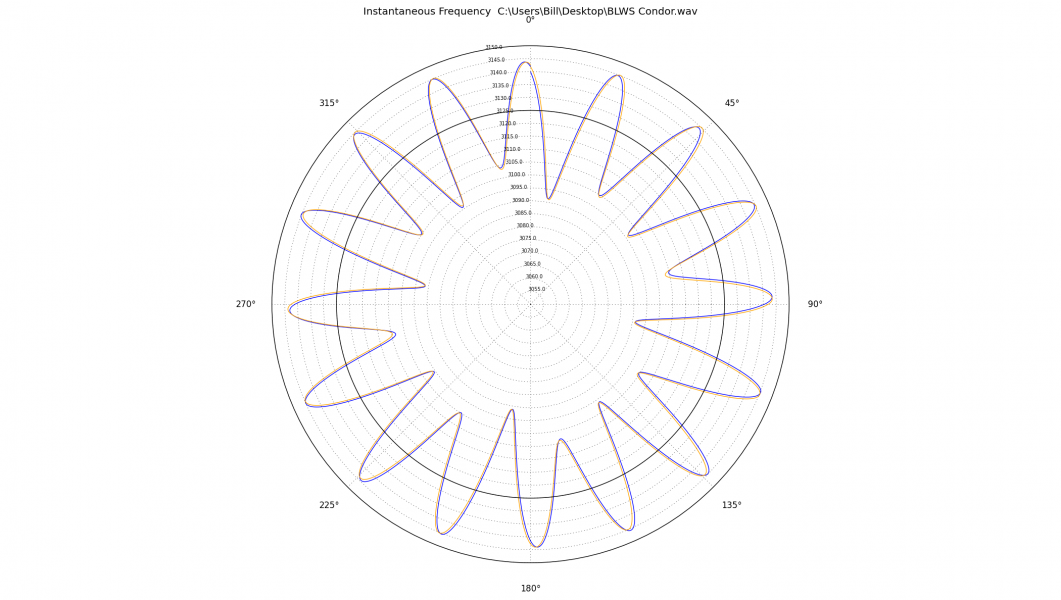
The scale is 5Hz/division so this represents ~1.6%PP. The plot was taken with a Condor drive which is 3 phase pure sinewave and crystal controlled but open loop, similar to your motor drive.
Using DSP and a dual PI control loop the same motor controlled with active feedback from the encoder:
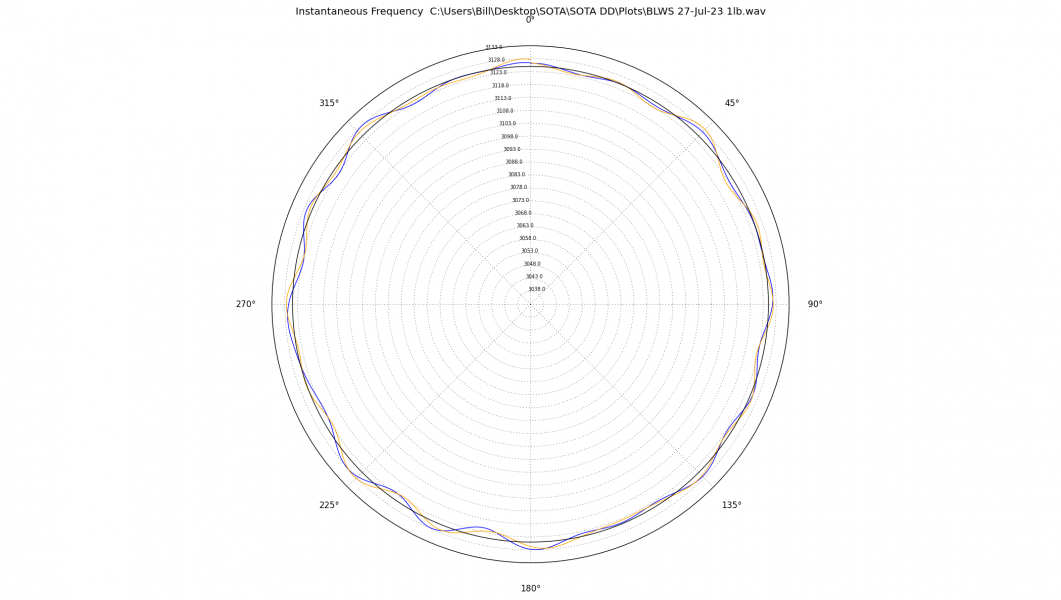
Same scale as the previous plot, but with better than 20dB of improvement.
Another view of the same phenomenon as above. This is the audio spectrum of the open loop Condor controller; if the motor was perfect, you would see a single peak at 3125Hz with no sideband, but because of the speed (frequency) modulation, you have numerous peaks every 20Hz:
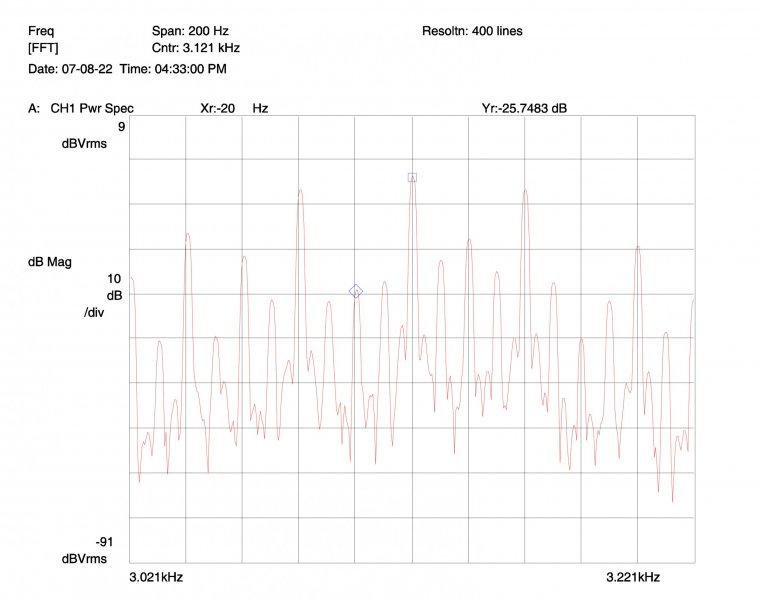
This is the audio spectrum of the same motor with the DSP controller; not perfect but a vast improvement:
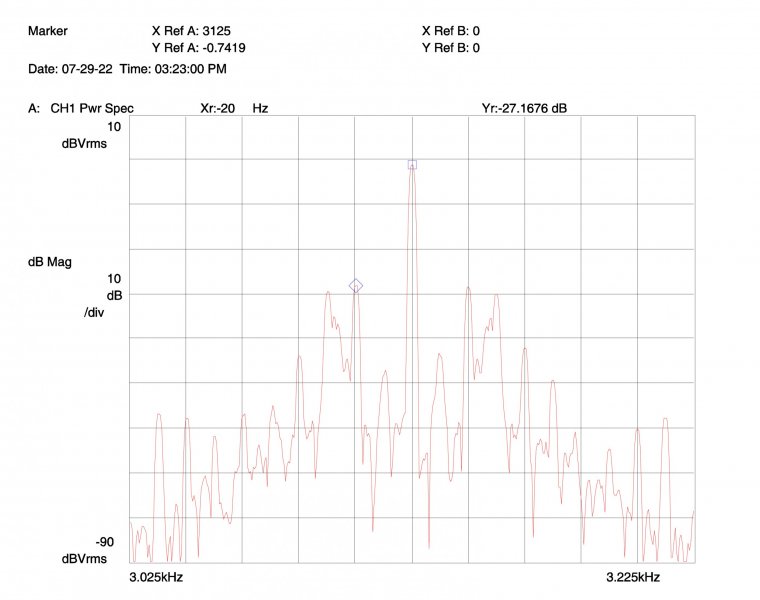
For comparison, this is the RF spectrum of the crystal used in the Condor controller (25MHz):
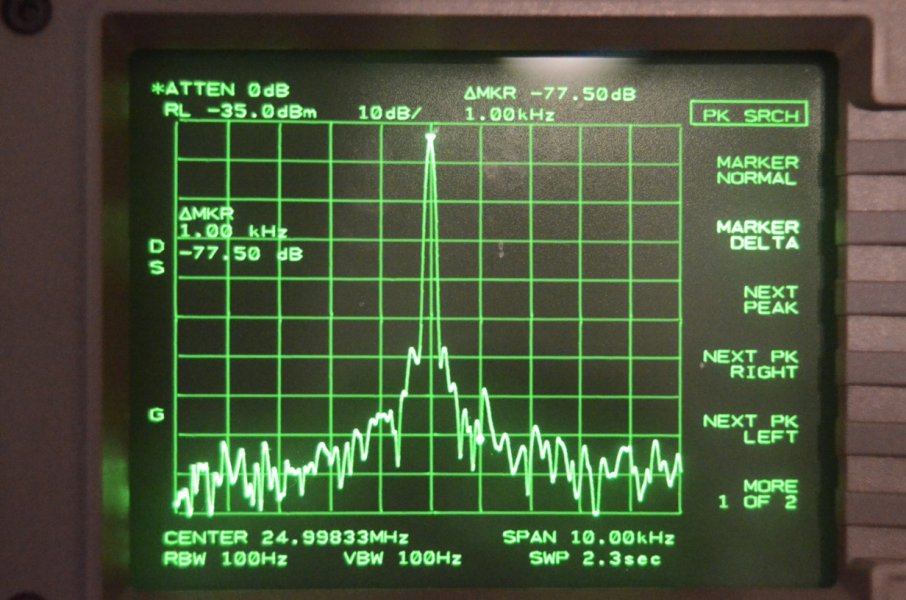
The marker is at a 1kHz offset and is 77dB below the fundamental. The frequencies will scale when you use this to produce 20Hz to drive the motor, so a 1kHz offset will become 0.8 mHz at the drive signal (that's less than 1 milli-Hz and it will be 77dB down). This is many orders of magnitude better than the oscillations of the motor due to cogging. Going with a TCXO would further improve the phase noise, but it will still be completely overwhelmed by the motor noise.

This is the audio spectrum of the same motor with the DSP controller; not perfect but a vast improvement:

For comparison, this is the RF spectrum of the crystal used in the Condor controller (25MHz):

The marker is at a 1kHz offset and is 77dB below the fundamental. The frequencies will scale when you use this to produce 20Hz to drive the motor, so a 1kHz offset will become 0.8 mHz at the drive signal (that's less than 1 milli-Hz and it will be 77dB down). This is many orders of magnitude better than the oscillations of the motor due to cogging. Going with a TCXO would further improve the phase noise, but it will still be completely overwhelmed by the motor noise.
thanks. exceeding my expectations for sure.Mike-
Beautiful table and interesting design. I'm glad it is meeting (exceeding?) your expectations.
he did measure it with the Shaknspin. "Though the Shaknspin (shaknspin. wordpress.com) isn’t a “lab-grade” test device, it’s 9 degrees of freedom sensor produces useful data. Better tables always produce better measured performance. Putting the OMA direct drive’s results side by side with the Grandioso’s makes clear that the MagneDrive system’s speed consistency (at least measured with this device) is comparable to the direct drive’s."It's interesting that Fremer didn't measure speed stability or accuracy; he normally does so in turntable reviews.
appreciate that coming from you.At any rate, it's a very innovative design and very well implemented.
i think you live in all the numbers and graphs. which i respect, but that is not for me. i love what hear from the T1.I just wish mfrs would be a little more forth-coming in their descriptions with more on the technical and a little less on the marketing side.
Last edited:
I raised some of these points previously but my queries were not really answered (not that many here could answer them). I asked about potential "cogging" from the magnetic coupling...which looks an awful lot like a standard gear drive just without the physical contact. I like how Transrotor and Paravicini did it where the magnets couple two platters, one above the other, so there is a more constant push of one magnet against another rather than a constant handoff between magnet and platter. I also asked how the clock works in this context...it didn't seem like the right application. Finally, I also asked if the motor was a zero cogging design (i.e. coreless). Glad to see someone else has eyes on this.Mike-
Beautiful table and interesting design. I'm glad it is meeting (exceeding?) your expectations.
Their website is heavy on marketing fluff and light on details, but several items I was wondering about have shown up in reviews and other sites. The MagneDrive system is synchronous so the platter does not need feedback to maintain proper speed, unlike belt drive and to some extent, idlers where proper motor speed does not equate to proper platter speed. Be that as it may, there is still some compliance between the magnetic rotor atop the drive motor and the platter as evidenced by the variable "torque" control; torque is a bit of a misnomer, perhaps variable coupling would be more accurate.
According to Fremer's review, the drive motor is a 3 phase BLDC type which is a good choice but unless it is a coreless motor, it will still have cogging. Driving it with a more sophisticated controller using DSP and Field Oriented Control (FOC) can reduce the cogging to negligible levels, but it requires feedback via a precision encoder, which apparently, Escoteric does not implement. The 42 lb platter will smooth a lot of that out, but I wonder if it could be improved upon further? Also it would be interesting to see how much cogging is produced by the variable reluctance between the drive magnets and the slotted platter. Maybe the mfr will chime in and give a few more details?
The external clock option makes sense for a digital source because of clock jitter (the G1X original design purpose) but it's difficult to see how it could make any difference in this implementation. The spec for W&F is 0.06% (a very decent number) but is several orders of magnitude higher than even a cheap crystal oscillator phase noise spec and would be absolutely swamped by any motor cogging. The motor is driven by "pure sinewaves" per Fremer's review, implying heavy analog filtering of the digitally produced drive signal which will ameliorate any timing errors. Speaking of which, PN specification was missing from their website for the G1X which is one of the most important specs for a device of this type, and given the amount of technology and effort put into it, should be worth publishing.
It's interesting that Fremer didn't measure speed stability or accuracy; he normally does so in turntable reviews.
At any rate, it's a very innovative design and very well implemented. I just wish mfrs would be a little more forth-coming in their descriptions with more on the technical and a little less on the marketing side.
i think you live in all the numbers and graphs. which i respect, but that is not for me. i love what hear from the T1.
Measurements are just tools; just like hand tools or power tools, if they are used incorrectly, you get bad results. That doesn't (and shouldn't) diminish the listening experience, it should compliment it. Each has its proper place; even an artist uses tools.
measurements are data points and tools. but also beside the point. Fremer finds that the better sounding turntables also measure better on the Shaknspin. so there seems to be a connection, and it's useful over time to see how it correlates in his experiences. but it's the experiences that matter. we need to be open to tools that show us things, but never be a slave to them.Measurements are just tools; just like hand tools or power tools, if they are used incorrectly, you get bad results. That doesn't (and shouldn't) diminish the listening experience, it should compliment it. Each has its proper place; even an artist uses tools.
Just saw the price on the G1X, YIKES! $30K for a frequency reference seems a tad steep.
Amazon is selling 10MHz OCXOs with frequency accuracy of 1PPB (1 x 10-9) for $17: Amazon OCXO
That's 10x more accurate than the G1X (@.01 PPM).
For $4K you can get a lab quality reference that is locked to a GPS signal for 1 x 10-13 freq stability: SRS Reference
100,000x more accurate than the G1X.
Phase noise is -140dB at 1kHz offset.
Amazon is selling 10MHz OCXOs with frequency accuracy of 1PPB (1 x 10-9) for $17: Amazon OCXO
That's 10x more accurate than the G1X (@.01 PPM).
For $4K you can get a lab quality reference that is locked to a GPS signal for 1 x 10-13 freq stability: SRS Reference
100,000x more accurate than the G1X.
Phase noise is -140dB at 1kHz offset.
fair comments. i think the retail is actually $27k USD, at least is was in March 23'. and btw, they are back ordered.Just saw the price on the G1X, YIKES! $30K for a frequency reference seems a tad steep.
Amazon is selling 10MHz OCXOs with frequency accuracy of 1PPB (1 x 10-9) for $17: Amazon OCXO
That's 10x more accurate than the G1X (@.01 PPM).
For $4K you can get a lab quality reference that is locked to a GPS signal for 1 x 10-13 freq stability: SRS Reference
100,000x more accurate than the G1X.
Phase noise is -140dB at 1kHz offset.
hey, i'm told the Nothing Rack for the AS-2000 is $50k. don't know that for sure, but does that make any more sense than this? are there cheaper racks? that perform as well?
any of those other clocks work just fine. and some T1 buyers already own older Esoteric Clocks they can and do use. but in the market the T1 plays in i think the tendency would be to not hold back.
i'm sure at some point someone will do a clock shootout. i understand that on the Esoteric digital players the new clock is said to be superior to those others. how that would play out on the T1 is a question.
better clocks make things sound better. is this that 'better' clock? i think so but have not done any comparisons myself.
Last edited:
better clocks make things sound better. is this that 'better' clock? i think so but have not done any comparisons myself.
It might be worth trying the Amazon offering; there is little downside at $17.
It would be interesting to see if any listeners could tell the difference in a blind A-B-C-X test (Internal osc/G1X/Amazon).
where is the break point where clock quality is not helping the T1? how much difference in performance will the clock quality make? that will be for others to find out. i'm happy and not asking that question. but it's a fair question.It might be worth trying the Amazon offering; there is little downside at $17.
It would be interesting to see if any listeners could tell the difference in a blind A-B-C-X test (Internal osc/G1X/Amazon).
there are plenty other threads and feedback on clock comparisons with digital. my guess would be that the same relevance for clock quality would apply here. i think the G1X has shown it's mettle so far in what i have read.
here is a review where the G1X clock is compared to an even more expensive Merging Technology clock in the context of an Esoteric digital player.
there are not many actual reviews of the G1X, other than Fremer's T1 review.
there are not many actual reviews of the G1X, other than Fremer's T1 review.
Last edited:
Fantastic table Mike, congrats!
I wonder if they borrowed some of the Continuum Caliburn learnings for this table in that they use magnetic levitation to lower the pressure on the bearing. I believe the large magnetic rings on the Continuum reduce the 84 lb weight of the platter to 6-8 lbs for the bearing to have much easier go of it.
I wonder if they borrowed some of the Continuum Caliburn learnings for this table in that they use magnetic levitation to lower the pressure on the bearing. I believe the large magnetic rings on the Continuum reduce the 84 lb weight of the platter to 6-8 lbs for the bearing to have much easier go of it.
thanks.Fantastic table Mike, congrats!
could be.I wonder if they borrowed some of the Continuum Caliburn learnings for this table in that they use magnetic levitation to lower the pressure on the bearing. I believe the large magnetic rings on the Continuum reduce the 84 lb weight of the platter to 6-8 lbs for the bearing to have much easier go of it.
but i think that the bearing approach likely was a result of trying to execute the touchless magnetic drive and still retain the 40 pound mass of the platter. something had to give to have the steadiness both from the mass and the drive. the magnetic bearing component was the answer to the riddle.
just my guess, i don't know. did they consider the Caliburn's approach as a guide?
thanks.
could be.
but i think that the bearing approach likely was a result of trying to execute the touchless magnetic drive and still retain the 40 pound mass of the platter. something had to give to have the steadiness both from the mass and the drive. the magnetic bearing component was the answer to the riddle.
just my guess, i don't know. did they consider the Caliburn's approach as a guide?
I don't know but it seems in any event it's a good approach to lower the demands on the bearing. I would guess that the team looked at the Caliburn given the reference level of the Esoteric product.
I wonder if they borrowed some of the Continuum Caliburn learnings for this table in that they use magnetic levitation to lower the pressure on the bearing. I believe the large magnetic rings on the Continuum reduce the 84 lb weight of the platter to 6-8 lbs for the bearing to have much easier go of it.
IMHO if there is anything to be borrowed it’s borrowed from La Platine Verdier not Continuum Caliburn. Full or partial magnetic levitation of a heavy platter is successfully used by Verdier turntable since 1979.did they consider the Caliburn's approach as a guide?
Yeah, maybe so. Maybe Continuum borrowed from Verdier and took it to a whole new level.IMHO if there is anything to be borrowed it’s borrowed from La Platine Verdier not Continuum Caliburn. Full or partial magnetic levitation of a heavy platter is successfully used by Verdier turntable since 1979.
Not sure but I hope it did.Yeah, maybe so. Maybe Continuum borrowed from Verdier and took it to a whole new level.
Similar threads
- Replies
- 14
- Views
- 2K
- Replies
- 85
- Views
- 21K
| Steve Williams Site Founder | Site Owner | Administrator | Ron Resnick Site Owner | Administrator | Julian (The Fixer) Website Build | Marketing Managersing |







